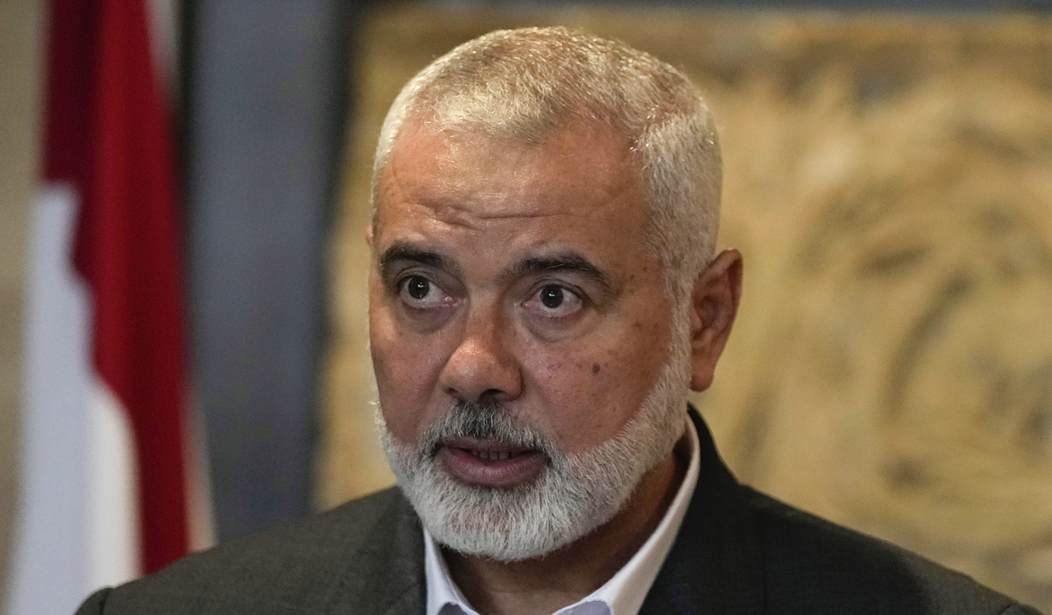Call it the gift that keeps on giving.
Israel stunned the world and humiliated the Iranians in killing Hamas chief Ismail Haniyeh this week while a guest in Tehran for the presidential inauguration. The explanation of how they carried out the precision bombing rattled the Iranians even more. The Mossad penetrated the Iranian Revolutionary Guard's most trusted protective service, hiring more than one of their agents to plant that bomb as well as others in a compound considered the most secure in Tehran:
The Telegraph [link here, paywalled -- Ed] cited two Iranian officials as saying that the initial plan was to assassinate Haniyeh when he was in Tehran in May for the funeral of the late Iranian president Ebrahim Raisi, who was killed in a helicopter crash. That operation was reportedly called off due to the large number of people in the building and the seemingly high possibility of failure.
Instead, according to the British daily, the agents went ahead and planted explosives in three different rooms at the compound, and later left Iran. The sources quoted in the report said surveillance footage shows them moving discretely from room to room. They reportedly detonated the bombs from abroad.
“They are now certain that Mossad hired agents from the Ansar al-Mahdi security unit,” an official in the Islamic Revolutionary Guard Corps told the newspaper, referring to a unit tasked with protecting senior officials.
Another IRGC official was quoted as saying: “It is a humiliation for Iran and a huge security breach.” The IRGC runs the guesthouse in an upscale neighborhood of Tehran where Haniyeh and other dignitaries were staying.
Apparently, July was a bad month for protective services globally. Just sayin'.
Anyway, the humiliation has produced one predictable result already. And for Israel, it couldn't come at a better time, and perhaps also for the long-restive population under the thumb of the IRGC and the mullahs:
Iran has arrested more than two dozen people, including senior intelligence officers, military officials and staff workers at a military-run guesthouse in Tehran, in response to a huge and humiliating security breach that enabled the assassination of a top leader of Hamas, according to two Iranians familiar with the investigation.
The high-level arrests came after the killing in an explosion early Wednesday of Ismail Haniyeh, who had led Hamas’s political office in Qatar and was visiting Tehran for the inauguration of Iran’s new president and staying at the guesthouse in northern Tehran, Iran’s capital. ...
The Revolutionary Guards Corps’ specialized intelligence unit for espionage has taken over the investigation and is hunting down suspects that it hopes will lead it to members of the assassin team that planned, aided and carried out the killing, according to the two Iranian officials, who requested anonymity because of the sensitive nature of the investigations.
The news of the sweeping arrests came after the Revolutionary Guards announced in a statement that “the scope and details of this incident are under investigation and will be announced in due course.”
Is this a mole hunt? Or is it the start of a purge? It could be both, and neither will make the IRGC or the regime more effective in the short term. Mole hunts distract even the best intelligence and security agencies, soaking up valuable resources that would normally focus outward to look inward instead. And the process of mole hunts necessarily derails efforts by those not investigating the breaches, by sheer intimidation as well as misdirection from top officials in order to trick their own agents into exposing themselves.
Purges are even worse, not just because of their usual scope. Purges in regimes like Iran usually involve dominant factions exerting power to get rid of their opponent factions while using the excuse of security. In the most memorable example, Stalin infamously purged thousands of his officers from the military not long before Hitler invaded the Soviet Union and nearly reached Moscow. The infighting could take years and leave the IRGC without enough focus to suppress popular discontent -- and also signal to that restive population that the time is ripe for change, not to mention add more dissenters to their mix.
Arresting a couple of dozen people in the immediate aftermath of the Haniyeh hit isn't a purge ... yet. But consider another famous example of a purge tied also to an assassination attempt: the 20 July 1944 Stauffenberg plot to kill Hitler. The Nazis had rounded up nearly all of the major Stauffenberg assassination plotters within a day, yet they ended up purging thousands by the time they finished. Almost 5,000 people got executed, some as Berlin was falling to the Russians nine months later. It doesn't take much for mole hunts to spin out of control into outright purges, especially in paranoid regimes already riven with internal tensions.
Israel took real risks of escalation with this operation. However, it may pay off in ways that will actually address the real danger they face, which is not Hamas or Hezbollah but the radical-Islamist regime in Tehran. Radical regimes are fragile regimes, and that's especially true of the mulllahs. They will have to choose whether to keep fighting Israel or focus on internal strength, and that decision point could be rapidly approaching.









Join the conversation as a VIP Member